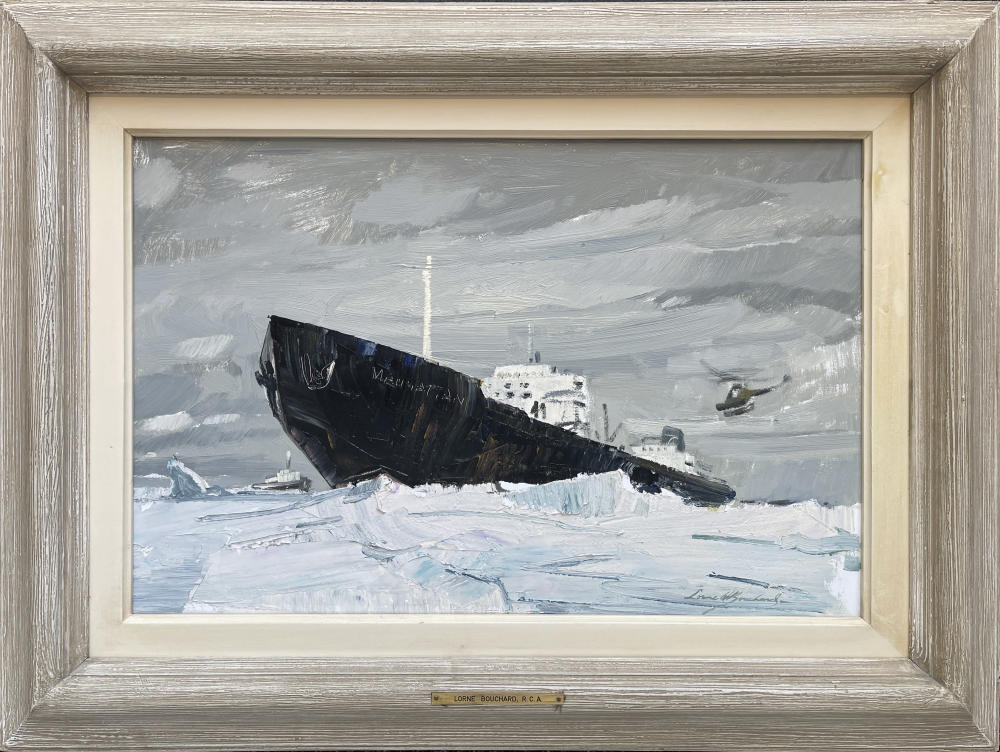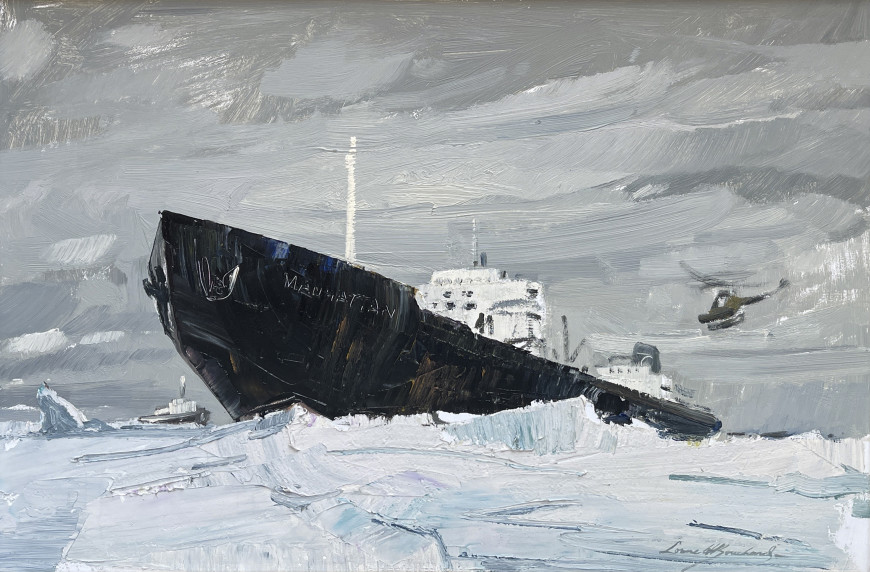-
Artworks
Lorne BouchardThe SS Manhattan & The Northwest Passage at Resolute Bay, 1969 (September 6th)1913-1978Oil on panel12 x 18 in
30.5 x 45.7 cmSoldInscriptions
Signed, ‘Lorne H. Bouchard’ (lower right); titled with description, ‘SS MANHATTAN / ARCTIC TEST CONVERSION / REVISED DIMENSIONS - 1005’ 6”/ BREADTH --- 155’ 0” (EXT) / DEPTH 67’ 6” / DRAFT 50’ 0”’ (verso, upper left) and dated, located and annotated, ‘SEPT. 6TH 1969/ (RESOLUTE BAY) / FROM NOTES TAKEN ABOARD BOEING 737 NORDAIR FLIGHT’ (verso, upper right) and signed with post nominals, ‘Lorne H. Bouchard, R.C.A.’ (verso, centre)Provenance
Walter Klinkhoff Gallery, Montreal;
Acquired from the above by present owner.
Lorne Bouchard’s introduction to the Arctic was in 1962 when he and his wife Lucille were guests of Claire and David Molson on their yacht “Laird River” and travelled the 1200 miles on the Mackenzie River, from Hay River on Great Slave Lake to the Beaufort Sea in the Western Arctic.
His introduction to the Eastern Arctic was thanks to the sponsorship of Mr. Jim Tooley, Chairman of Nordair. In a sketch of Mr. Tooley of 1971, the Montreal Gazette, writing of Nordair's service by jet aircraft, a 737 with adapted landing gear enabling it to land on short gravel landing strips, and which changed and improved life for communities in the eastern Arctic, Mr. Tooley said, “When we introduced the 737 to the North we revolutionized everything. We cut flying time between Frobisher and Montreal to 3 hours and broke the isolation. Ordinary little things become important up here like getting fresh fruits and vegetables 24 hours a day. It was never heard of until we began using the jet”, he continued.
From Frobisher Bay, Nordair had 15 piston aircraft which served other smaller communities in the Eastern Arctic. (Mr. Tooley is one of the many great Canadian business success stories who were born and raised in Winnipeg and left to pursue what were greater opportunities elsewhere. Gerry Schwartz is an obvious contemporary example.)
Mr. Tooley’s Nordair hosted Bouchard’s first trip to the Eastern Arctic in the spring of 1969. The Bouchard website notes that Lorne wrote in a diary that he sketched from the DC -3’s co-pilot’s seat “en route to various points Cape Dorset, Pangnirtung, Broughton Island, Frobisher Bay (Baffin Island) also a short stop at Fort Chimo. I was on the first 737 jet to land at Resolute.”
About his second trip to the Eastern Arctic of September 1969, Bouchard wrote that Mr. Tooley’s invitation was “to record passage of oil tanker Manhattan off Resolute Bay through Northwest passage, also a week's stay at Frobisher in September. During the trip in March 1969, filmmaker John Bassett of Montréal accompanied me to the Arctic and from this combined expedition came the film, in color, entitled "LORNE BOUCHARD, an artist's impression of the ARCTIC. II [1]”.
Lorne Bouchard’s daughter, Joyce, recently recounted to Alan Klinkhoff of Mr. Tooley’s hospitality when he invited the Bouchard family to his home for a screening of the John Bassett film: Mr. Tooley made a memorable Irish coffee, she recalled fully 50 years later. Bouchard was to return to the Eastern Arctic region to paint in 1974 and 1975, again as a guest of Nordair, under the sponsorship of Mr. Tooley.
The voyage of the S.S. Manhattan was one of exploration for oil and its commercial potential, supplying the Eastern seaboard, it was also one of political and territorial interest. With no less than eight countries with territorial borders on the Arctic, the prospect of a commercially viable oil supply in the region would or could offer great wealth to countries who have jurisdiction over the area where the oil could be exploited. In Canada’s case one adds the ongoing debate of jurisdiction with our northern peoples.
The S.S. Manhattan made a historic voyage to test the feasibility of using the Arctic Northwest Passage as a year round trade route. Humble Oil & Refining Co., the sponsor of the project, hoped to prove that the Passage could be used by special ships to deliver Arctic oil to U.S. East Coast ports. The cost for this project reached $54 million. Benefits of an open Polar sea route included increasing U.S. self-sufficiency in oil.
On September 2, 1969, the S.S.Manhattan turned her huge armoured bow toward Baffin Island and started encountering her first ice floes, approximately 14 feet thick. The Manhattan, cracking off half-acre floes, sailed on without a quiver. As the blocks grew larger, more power was required and the Manhattan broke through ice floes as thick as 60 feet. When in the McClure strait however, ice 15 to 20 feet high and sometimes as deep as 100 feet proved too much for the Manhattan. Ploughing into thick ice, backing out and going forward again and making very little headway and requiring icebreakers to relieve the pressure on the side of the ship, on September 11, the Manhattan changed course to the Prince of Wales strait, the more normal route for the Passage. On September 14, the prow of the Manhattan cracked the last floe at the southern end of Prince of Wales Strait and ahead lay 1,000 miles of open water. Upon reaching Prudhoe Bay, the Manhattan took on a ceremonial barrel of oil. The return trip was completed on November 12, when the tanker sailed into New York Harbor. In spite of its accomplishments, the data acquired during this and a second trip concluding that, at the present time, the use of supertankers to move oil from Prudhoe Bay to the East Coast, was not economical nor efficient. As a result, the Trans-Alaska Pipeline System was established. This study ultimately resulted in Humble joining other oil companies in building the Trans-Alaska line.
The aforementioned was compiled and transcribed from numerous resources including National Geographic (March, 1970), The Lamp (Spring, 1970), American Society for Engineering Education Annual Meeting, June 21-24, 1971.
_________________________________
Footnote
1. Biography” www.lornehbouchard.ca, n/d (http://www.lornehbouchard.ca/en/bio/index.html)











